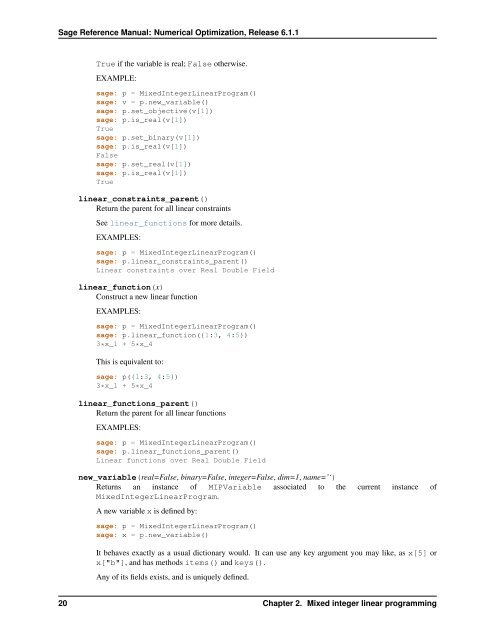Sage Reference Manual: Numerical Optimization - Mirrors
Sage Reference Manual: Numerical Optimization - Mirrors
Sage Reference Manual: Numerical Optimization - Mirrors
Create successful ePaper yourself
Turn your PDF publications into a flip-book with our unique Google optimized e-Paper software.
<strong>Sage</strong> <strong>Reference</strong> <strong>Manual</strong>: <strong>Numerical</strong> <strong>Optimization</strong>, Release 6.1.1<br />
True if the variable is real; False otherwise.<br />
EXAMPLE:<br />
sage: p = MixedIntegerLinearProgram()<br />
sage: v = p.new_variable()<br />
sage: p.set_objective(v[1])<br />
sage: p.is_real(v[1])<br />
True<br />
sage: p.set_binary(v[1])<br />
sage: p.is_real(v[1])<br />
False<br />
sage: p.set_real(v[1])<br />
sage: p.is_real(v[1])<br />
True<br />
linear_constraints_parent()<br />
Return the parent for all linear constraints<br />
See linear_functions for more details.<br />
EXAMPLES:<br />
sage: p = MixedIntegerLinearProgram()<br />
sage: p.linear_constraints_parent()<br />
Linear constraints over Real Double Field<br />
linear_function(x)<br />
Construct a new linear function<br />
EXAMPLES:<br />
sage: p = MixedIntegerLinearProgram()<br />
sage: p.linear_function({1:3, 4:5})<br />
3*x_1 + 5*x_4<br />
This is equivalent to:<br />
sage: p({1:3, 4:5})<br />
3*x_1 + 5*x_4<br />
linear_functions_parent()<br />
Return the parent for all linear functions<br />
EXAMPLES:<br />
sage: p = MixedIntegerLinearProgram()<br />
sage: p.linear_functions_parent()<br />
Linear functions over Real Double Field<br />
new_variable(real=False, binary=False, integer=False, dim=1, name=’‘)<br />
Returns an instance of MIPVariable associated to the current instance of<br />
MixedIntegerLinearProgram.<br />
A new variable x is defined by:<br />
sage: p = MixedIntegerLinearProgram()<br />
sage: x = p.new_variable()<br />
It behaves exactly as a usual dictionary would. It can use any key argument you may like, as x[5] or<br />
x["b"], and has methods items() and keys().<br />
Any of its fields exists, and is uniquely defined.<br />
20 Chapter 2. Mixed integer linear programming
















